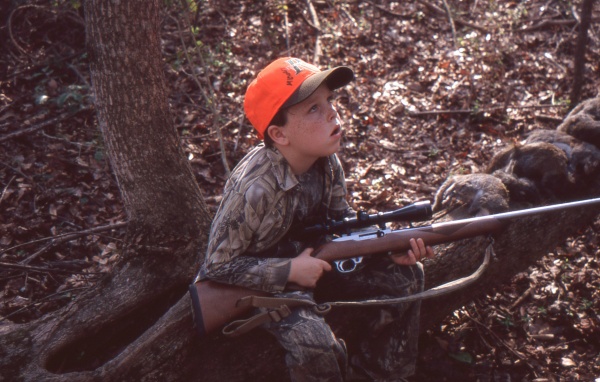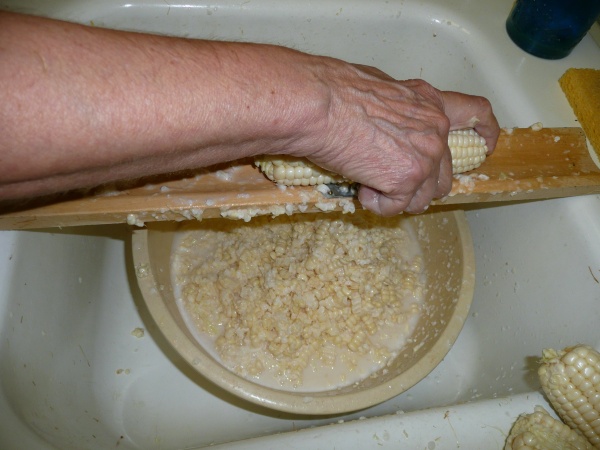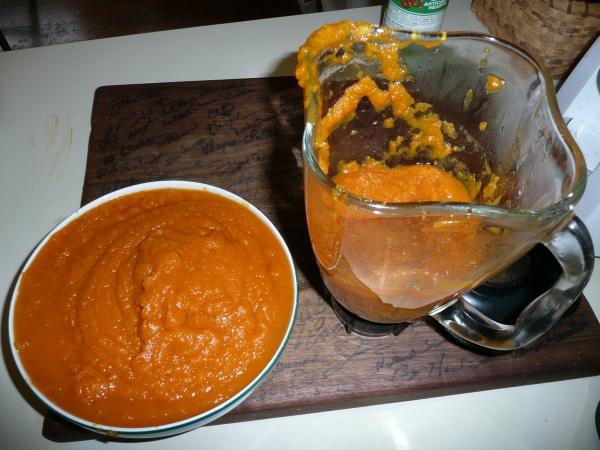A YEARNING FOR NOVEMBERS OF YESTERYEAR

This young hunter already has a fine batch of
bushytails and the making of some mighty fine eating
I have countless fond recollections of November stretching as far back as my memory spans.
They encompass such things as the opening of rabbit season and the joy of hearing beagles hot on a cottontail’s trail, the sheer culinary delight and spirit of thankful good will associated with the extended family gathered together to celebrate Thanksgiving, Momma’s baking applesauce cakes to be stored in a cool place until Christmas feasting, or sitting shivering in the gloaming atop a ridge adorned by hickory trees awaiting the first squirrel to show as night gave way to light. There was the excitement and culinary wonder of hog-killing time with the month’s first cold snap and heavy frost, a wonderful weekend quail hunt with my father-in-law when he decided that maybe the upstart who had stolen his daughter wasn’t a total disaster, and the poverty-stricken years of graduate school when a baked chicken or pair of Cornish hens for Thanksgiving with my wife and me was a feast which helped dispel the loneliness from being away from those who had raised me.

Creamed corn has always been a part of our Thanksgiving feasting
Most of all though I remember Thanksgiving in recent decades, a time when Mom and Dad were gone and when our home became the center of celebration as our daughter and her family joined us. There were many patchwork parts which went into making the whole of a time of sheer joy. The menu planning, although there were always certain staples which were “must haves”—a roasted turkey, chestnut dressing honoring a family tradition stretching back to early in the 20th century, pumpkin or candy roaster pie, creamed corn which came from Silver Queen grown in my garden, biscuits, and gravy. When we settled down to the feast, my wife, Ann, would always ask that each person seated at the table offer a few thoughts on what had transpired over the course of the previous year for which they were particularly thankful.
The thoughts expressed ranged widely. I often mentioned a new book which had appeared, some welcome writing assignment or contract which brought a measure of often needed financial stability, or perhaps just appreciation for a great turkey hunting spring or a successful period of deer hunting. Our daughter often referred to some achievement in college or, later, at work or something connected with her daughter. Ann, however, was predictable. Year after year she expressed her appreciation for family, for the opportunity to be together, for a year graced by good fortune, and the simple blessings associated with a love of life.

Those times ended several years ago when the ravishing grips of dementia laid hold of her mind and left only a shell of a vibrant woman with a true lust for the simple, satisfying things we associate with day-to-day existence. Now her body has joined her mind in concluding Ann’s earthly journey. She died on October 29 and left a void which assails my mind even as it carries me back to all the good years and decades as surely as fall gives way to winter. Thanksgiving won’t be the same, this year or ever again, but such is life’s cycle. I’ll go on, sustained by friends and family, uplifted by the healing powers of hard work (the Protestant ethic has always been close to the surface with me and all those close to me), and an abundance of fond memories which bring gladness even in the midst of sadness.
I’m enough of a realist to recognize that nostalgia can be a nostrum with magical healing powers, and for this newsletter, for the present, and likely for as far as I can see into the future it will be a daily companion. In truth, that’s been the case for a long time. Those of you who have been gracious enough to read this newsletter over an extended period realize as much, because the one constant in its contents is a harkening back to the world we have to no small degree lost.

Speaking of that world, only a few days after Ann’s death, with the shock of it still holding me in a firm, painful grip, never mind that her passing had been expected for some time and was in myriad ways a blessing, it came back to the forefront in a significant way. My book, A Smoky Mountain Boyhood: Memories, Musings, and More, many years in the writing and a couple of years in the publishing process, arrived. I shared a special notice of its appearance with you and a gratifying number of orders have already come in.
I’m the last person to judge its merits, but I do feel confident in saying it comes from the heart and is likely as well done as my capabilities permit. Early reaction to it has been consistently positive, and if nothing else I’d like to think that it gives detailed insight to what life was like for a youngster growing up in rural Appalachia in the middle of the last century. It’s part memoir but more a look at a special time and a magical place with the overriding intention of offering a window to that world of yesteryear I knew as did many of you.
Signed and inscribed copies of the book, which encompasses 41 chapters, well over 300 pages, an extensive selection of vintage photos, a glossary of mountain vocabulary, and an index, are available directly from me (Jim Casada, 1250 Yorkdale Drive, Rock Hill, SC 29730) for $29.95 + $5 shipping and handling. The $5 shipping cost remains the same whether one or multiple copies are ordered. The timing is good for Christmas, of course, and by the time you receive this the book can probably be ordered through my website (www.jimcasadaoutdoors.com) using PayPal as well as by mail. If you acquire it I hope it will bring joy and as always I’d welcome your thoughts and input.
********************************************************************************
ON THE LIGHTER SIDE: THE MIRTHFUL INNOCENCE OF YOUTH
Several decades ago, when my youngest nephew Will was just beyond the toddler stage, full of the exuberance and unbridled outspokenness which is the special preserve of youth, I visited his parents, Br’er Don and his wife, Susan, at their home near Raleigh, NC. I arrived in mid-afternoon and Don was still at work. Will was out in the yard playing and immediately ran to greet me upon arrival. Without so much as a “Hello, Uncle Jim” or indeed words of any kind, he asked me straight out, “Uncle Jim, have you got a peenie.” That’s the way, incidentally, he pronounced the last word.
I replied that I didn’t think I had one but dug around in my front pockets just to be sure. “No Will,” I said, “I afraid I don’t have a penny.” He looked at me in obvious dismay, clearly upset by the lack of the article about which he had inquired. About that time his mother arrived on the scene, and he turned to her, almost in tears, and said: “Momma, Uncle Jim doesn’t have a peenie.” Susan turned several shades of scarlet before explaining to me, even as she tried to reassure her distraught offspring, that Will wasn’t inquiring about money.
Instead, as is often the case with small boys, he was fascinated by the male appendage and his parents had taught him to refer to his penis as a “peenie.” My failure to make the correct interpretation of the word, compounded considerably by digging in my pockets and not locating the object of his intense interest, suddenly became all too obvious to me. Now, with Will grown, married, and having his own male offspring, the subject of the missing “peenie” still comes into play almost every time the family gets together.
JIM’S DOIN’S
Obviously, as the personal information shared above would indicate, much of my time of late has been occupied with all the matters associated with the death of a loved one. There’s not just grief but a seemingly unending array of paperwork involving funeral arrangements (we had no service because of coronavirus but hope to celebrate Ann’s life at some unknown point in the future with good food, telling of tales, singing of songs, playing of instruments, a toast or two, and tributes to the woman she was), death certificates, probate, Social Security, jointly held property of all sorts, and a veritable flood of required actions. Still, writing is an escape, a place of quiet refuge for a soul in turmoil, and I’ve been at it with a will.
The current issue of South Carolina Wildlife has my article, “Growing Up with Grandpa Joe,” in it. The piece is a much-abbreviated version of a chapter in the above-mentioned book devoted to Grandpa. My “Mountain Wisdom and Ways” column for the next issue of Carolina Mountain Life carries the title “Walks in Winter.” It will likely appear about the time you get this newsletter. I’ve been doing an ongoing series of culinary pieces for Smoky Mountain Living, and they have been special to me because the byline for them reads “Ann and Jim Casada.” That’s only fair, because many of the recipes shared in the pieces were her creations. While I’d like to think I’m a pretty fair hand in the kitchen, there’s no question whatsoever that her cooking abilities left me somewhere far behind. The coverage in the current magazine is on “The Wonders of Winter Squash” and features recipes using cushaws, candy roasters, pumpkins, acorn squash, and butternut squash. Then of course there’s the above-mentioned book, A Smoky Mountain Boyhood.
Finally, just this past week I agreed to take on two book-length projects connected with Sporting Classics magazine. One will be an anthology of great turkey-hunting tales similar to my previous works for the same publisher, The Greatest Quail Hunting Book Ever and The Greatest Deer Hunting Book Ever (both are available through my website, www.jimcasadaoutdoors.com) and would make fine Christmas gifts. The second will be an original work on great African hunters and hunter-explorers offering biographical essays on each of perhaps thirty such individuals such as Sam Baker, Fred Selous, Cornwallis Harris, and Theodore Roosevelt, along with literary giants such as Robert Ruark, Ernest Hemingway, and Peter Capstick. Those endeavors, along with works I already have in progress, certainly should keep me busy.
RECENT READING
As is often my wont, I’ve been on a one-author binge of late, plunging through one Wilbur Smith novel after another with pure delight. He’s written scores of books over the course of an amazingly long and productive career. Many of the works I’ve been reading are repeats for me, but he’s so good, so accurate with his historical background (almost all his books have African settings), and so gifted with words and setting a scene he never palls. Incidentally, I have many of his works for sale on my website, www.jimcasadaoutdoors.com, where numerous entries are devoted to Smith in the African list. Decidedly different in nature, but again a pure delight, is Fire in the Straw: Notes on Inventing a Life, Nick Lyons’ latest book. Nick is a literary icon in the field of fly-fishing literature, and he writes in a fashion struggling wretches like this one can only dream about. As its subtitle suggests, this book is a memoir, although it just looks at snippets of Nick’s life, but goodness, is it powerful.
RECIPES FOR THE SEASON

In my memory and given my strong sense of tradition, November evokes recollections of culinary fare where winter squash and game dishes loomed large. We grew cooking pumpkins and various types of other “keeper” squash, and in Momma’s eyes no Thanksgiving array of foodstuffs in general, and desserts in particular, was complete with a pumpkin chiffon pie. Similarly, we had been enjoying squirrel as a main dish since the season opened in mid-October, and with the arrival of rabbit hunting late in November that meat became something of a fixture on the family table. Here’s a quintet of recipes looking back to those halcyon days, and they are just as scrumptious now as they were in long ago yesteryear.
HASH BROWN POTATOES WITH SQUIRREL
2 cups cooked, deboned squirrel meat
3 medium potatoes
1/3 cup bacon drippings
½ cup finely diced sweet onion
½ teaspoon salt
Several dashes freshly ground black pepper
Remove stewed squirrel from bones and chop into small pieces. Peel and coarsely grate potatoes. Put drippings in skillet and heat. Sprinkle onion, squirrel, and seasonings over potatoes. Cover and cook moderately fast until potatoes are browned on underside. Stir to blend, turn over, cover, and brown on the other side. Total cooking time is approximately 10 minutes. Serve immediately.
RABBIT BOG
1 rabbit stewed and deboned
Salt to taste
1 medium onion, chopped fine
2-3 celery ribs, chopped
Black pepper to taste
¼ to 1/2 pound smoked venison sausage (or kielbasa)
1 cup uncooked long grain rice
Cut rabbit into pieces, sprinkle with salt, and place in a Dutch oven with enough cold water to cover completely. Add onion, celery, and pepper. Bring o a boil; reduce heat, cover and simmer until rabbit is tender and readily separates from the bones. Remove rabbit, saving the broth. Let cool and then debone.
Measure broth back into the pot (it is not necessary to drain onion and celery) adding water if necessary to make four cups of liquid. Return squirrel to pot. Cut sausage into ¼ inch slices. Add to pot along with rice. Stir and all more salt and pepper to taste. Bring to a boil, reduce heat, cover and simmer for about 30 minutes or until most of the broth is absorbed by the rice or until the rice grains are tender and fluffy.
CANDY ROASTER CASSEROLE
Candy roasters are a decidedly regional member of the squash family, but they have a long,
strong culinary history in southern Appalachia. Easily grown, hardy keepers, less stringy than pumpkin, and perhaps the sweetest of the winter squash, they are delightful whether used as a vegetable/fruit dish or in desserts. Pretty much any recipe for pumpkins or sweet potatoes is suitable for candy roasters, but a longtime family favorite is a sweetened version somewhat similar to a sweet potato casserole or applesauce with cinnamon and brown sugar.
1 medium to large candy roaster (will produce about 10 cups of cubed squash)
½ cup brown sugar
½ cup molasses
1 stick butter
¼ cup orange juice and a tablespoon orange zest
Pinch of salt
1 tablespoon cinnamon or all-spice
½ cup chopped pecans or black walnut meats
Prepare the candy roaster by peeling (a heavy-duty vegetable scraper is handy for this), removing the seeds, and cutting into cubes about an inch in size. Place in a casserole or baking dish with a pat of butter.
Combine all the other ingredients except the nuts in a pan and melt/blend over low heat to make a sauce, then pour over the candy roaster. Make sure to coat all the cubes completely.
Bake at 350 degrees for 45-50 minutes or until the candy roaster cubes are tender. Once that point is reached, top with the nuts and bake for 2-3 more minutes.
PUMPKIN CHIFFON PIE
The word “cooking” is added simply because many of today’s store-bought pumpkins are
suitable only for decorative use. Even my Grandpa Joe, who wouldn’t have known a Halloween pumpkin from Adam’s off ox, distinguished between cooking pumpkins and field pumpkins (the latter used primarily as hog food). My favorite cooking pumpkin is an heirloom variety from seed with origins tracing back to Chambers Creek, which empties into the north shore of Fontana Lake, in pre-Great Smoky Mountains National Park Days. It is sweet, has far less fiber than most pumpkins, and works up with relative ease.
Mention pumpkin pie and most folks think of baked ones, but this chiffon pie requires refrigeration rather and an oven.
3 eggs
1 cup sugar
1 ¼ cups cooked pumpkin
½ cup milk
1 tablespoon orange juice
½ teaspoon orange zest
½ teaspoon salt
½ teaspoon nutmeg
½ teaspoon cinnamon
1 tablespoon unflavored gelatin
¼ cup cold water
Separate eggs and to yolks add ½ cup sugar, pumpkin, milk, orange juice, zest, spices, and salt. Cook in a double boiler until thick. Soften gelatin in cold water and add to hot pumpkin mix. Mix thoroughly and cool. When it begins to thicken, fold in stiffly beaten egg whites to which remaining half cup of sugar has been added. Pour atop a prepared graham cracker or ginger snap crust. Chill in refrigerator for 3-4 hours.
BROWN SUGAR BAKED ACORN SQUASH
Easily grown in the home garden and readily available at the grocery store, acorn squash also
offer the advantage of being much smaller than most types of winter squash (a single one is just right for two ample servings). This recipe is simple, requires little prep time, and has long been a family favorite. It’s rich, but Momma always used it as a side dish, not a dessert.
1 acorn squash per two diners
Brown sugar (molasses, cane syrup, maple syrup, or honey can be substituted)
Butter
With a sharp, sturdy butcher knife cut the squash in half length-wise and use a spoon the scrape out the seeds and stringy pulp surrounding them. Lightly score the flesh of the squash, being sure you don’t cut all the way through. Place the squash halves on a cookie sheet or in a baking dish. Put 1-2 pats of butter in the cavity and then fill the remaining space with brown sugar or the sweetener of your choice. Bake at 400 degrees for an hour to an hour and 15 minutes (until squash is tender). Serve hot either as a sweet vegetable dish (the way my family ate it) or dessert.